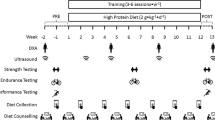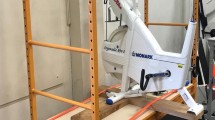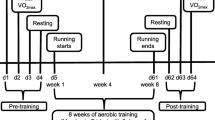Abstract
Purpose
To compare the effects of external pneumatic compression (EPC) and sham when used concurrently with high intensity interval training (HIIT) on performance-related outcomes and recovery-related molecular measures.
Methods
Eighteen recreationally endurance-trained male participants (age: 21.6 ± 2.4 years, BMI: 25.7 ± 0.5 kg/m2, VO2peak: 51.3 ± 0.9 mL/kg/min) were randomized to balanced sham and EPC treatment groups. Three consecutive days of HIIT followed by EPC/sham treatment (Days 2–4) and 3 consecutive days of recovery (Days 5–7) with EPC/sham only on Days 5–6 were employed. Venipuncture, flexibility and pressure-to-pain threshold (PPT) measurements were made throughout. Vastus lateralis muscle was biopsied at PRE (i.e., Day 1), 1-h post-EPC/sham treatment on Day 2 (POST1), and 24-h post-EPC/sham treatment on Day 7 (POST2). 6-km run time trial performance was tested at PRE and POST2.
Results
No group × time interaction was observed for flexibility, PPT, or serum measures of creatine kinase (CK), hsCRP, and 8-isoprostane. However, there was a main effect of time for serum CK (p = 0.005). Change from PRE in 6-km run times at POST2 were not significantly different between groups. Significant between-groups differences existed for change from PRE in atrogin-1 mRNA (p = 0.018) at the POST1 time point (EPC: − 19.7 ± 8.1%, sham: + 7.7 ± 5.9%) and atrogin-1 protein concentration (p = 0.013) at the POST2 time point (EPC: − 31.8 ± 7.5%, sham: + 96.0 ± 34.7%). In addition, change from PRE in poly-Ub proteins was significantly different between groups at both the POST1 (EPC: − 26.0 ± 10.3%, sham: + 34.8 ± 28.5%; p = 0.046) and POST2 (EPC: − 33.7 ± 17.2%, sham: + 21.4 ± 14.9%; p = 0.037) time points.
Conclusions
EPC when used concurrently with HIIT and in subsequent recovery days reduces skeletal muscle markers of proteolysis.




Similar content being viewed by others
Abbreviations
- 4HNE:
-
4-Hydroxynonenal
- Ac:
-
Acetylated
- ANOVA:
-
Analysis of variance
- APMHR:
-
Age predicted max heart rate
- BCA:
-
Bicinchonic acid
- BSA:
-
Bovine serum albumin
- CK:
-
Creatine kinase
- ES:
-
Effect size
- Fbl:
-
Fibrillarin
- GAPDH:
-
Glyceraldehyde 3-phosphate dehydrogenase
- hsCRP:
-
High sensitivity C-reactive protein
- EPC:
-
External pneumatic compression
- GXT:
-
Graded exercise testing
- GPx:
-
Glutathione peroxidase
- HIIT:
-
High intensity interval training
- IgG:
-
Immunoglobulin G
- IκBα:
-
Nuclear factor of kappa B (NF-κB) inhibitor alpha
- IL:
-
Interleukin
- HR:
-
Heart rate
- MCP-1:
-
Monocyte chemoattractant protein-1
- MuRF-1:
-
Muscle RING finger 1
- NSAIDs:
-
Non-steroidal anti-inflammatories
- NF-κB:
-
Nuclear factor of kappa B
- PGC-1α:
-
Peroxisome proliferator-activated receptor coactivator 1-alpha
- poly-Ub:
-
Poly-ubiquitinated
- PPARGC1A:
-
Peroxisome proliferator-activated receptor gamma coactivator 1-alpha
- PPT:
-
Pressure-to-pain threshold
- SOD2:
-
Superoxide dismutase 2
- TNF-α:
-
Tumor necrosis factorα
References
Baar K (2004) Involvement of PPARγ co-activator-1, nuclear respiratory factors 1 and 2, and PPARα in the adaptive response to endurance exercise. Proc Nutr Soc 63(2):269–273
Biolo G, Tipton KD, Klein S, Wolfe RR (1997) An abundant supply of amino acids enhances the metabolic effect of exercise on muscle protein. Am J Physiol 273(1 Pt 1):E122–E129
Biolo G, Williams BD, Fleming RY, Wolfe RR (1999) Insulin action on muscle protein kinetics and amino acid transport during recovery after resistance exercise. Diabetes 48(5):949–957
Black S, Kushner I, Samols D (2004) C-reactive Protein. J Biol Chem 279(47):48487–48490. doi:10.1074/jbc.R400025200
Brancaccio P, Maffulli N, Limongelli FM (2007) Creatine kinase monitoring in sport medicine. Br Med Bull 81–82:209–230. doi:10.1093/bmb/ldm014
Braun WA, Dutto DJ (2003) The effects of a single bout of downhill running and ensuing delayed onset of muscle soreness on running economy performed 48 h later. Eur J Appl Physiol 90(1–2):29–34
Cheung K, Hume PA, Maxwell L (2003) Delayed onset muscle soreness. Sports Med 33(2):145–164
Chotechuang N, Azzout-Marniche D, Bos C, Chaumontet C, Gaudichon C, Tome D (2011) Down-regulation of the ubiquitin-proteasome proteolysis system by amino acids and insulin involves the adenosine monophosphate-activated protein kinase and mammalian target of rapamycin pathways in rat hepatocytes. Amino Acids 41(2):457–468. doi:10.1007/s00726-010-0765-2
Cochrane D, Booker H, Mundel T, Barnes M (2013) Does intermittent pneumatic leg compression enhance muscle recovery after strenuous eccentric exercise? Int J Sports Med 34(11):969–974
Haun CT, Roberts MD, Romero MA, Osburn SC, Mobley CB, Anderson RG, Goodlett MD, Pascoe DD, Martin JS (2017) Does external pneumatic compression treatment between bouts of overreaching resistance training session exert differential effects on molecular signaling and performance-related variables compared to passive recovery? An exploratory study. PLoS One 12(6):e0180429. doi:10.1371/journal.pone.0180429
Keck NA, Cuddy JS, Hailes WS, Dumke CL, Ruby BC (2015) Effects of commercially available pneumatic compression on muscle glycogen recovery after exercise. J Strength Cond Res 29(2):379–385. doi:10.1519/JSC.0000000000000772
Kee AJ, Taylor AJ, Carlsson AR, Sevette A, Smith RC, Thompson MW (2002) IGF-I has no effect on postexercise suppression of the ubiquitin-proteasome system in rat skeletal muscle. J Appl Physiol (1985) 92(6):2277–2284. doi:10.1152/japplphysiol.01030.2001
Kephart WC, Mobley CB, Fox CD, Pascoe DD, Sefton JM, Wilson TJ, Goodlett MD, Kavazis AN, Roberts MD, Martin JS (2015) A single bout of whole-leg, peristaltic pulse external pneumatic compression upregulates PGC-1alpha mRNA and endothelial nitric oxide sythase protein in human skeletal muscle tissue. Exp Physiol 100(7):852–864. doi:10.1113/EP085160
Kolka CM, Bergman RN (2012) The barrier within: endothelial transport of hormones. Physiology (Bethesda) 27(4):237–247. doi:10.1152/physiol.00012.2012
Lecker SH, Solomon V, Price SR, Kwon YT, Mitch WE, Goldberg AL (1999) Ubiquitin conjugation by the N-end rule pathway and mRNAs for its components increase in muscles of diabetic rats. J Clin Investig 104(10):1411–1420. doi:10.1172/JCI7300
Louis E, Raue U, Yang Y, Jemiolo B, Trappe S (2007) Time course of proteolytic, cytokine, and myostatin gene expression after acute exercise in human skeletal muscle. J Appl Physiol (1985) 103(5):1744–1751. doi:10.1152/japplphysiol.00679.2007
MacDonald GZ, Penney MD, Mullaley ME, Cuconato AL, Drake CD, Behm DG, Button DC (2013) An acute bout of self-myofascial release increases range of motion without a subsequent decrease in muscle activation or force. J Strength Cond Res 27(3):812–821. doi:10.1519/JSC.0b013e31825c2bc1
Martin JS, Borges AR, Beck DT (2015a) Peripheral conduit and resistance artery function are improved following a single, 1-h bout of peristaltic pulse external pneumatic compression. Eur J Appl Physiol 115(9):2019–2029. doi:10.1007/s00421-015-3187-8
Martin JS, Friedenreich ZD, Borges AR, Roberts MD (2015b) Acute effects of peristaltic pneumatic compression on repeated anaerobic exercise performance and blood lactate clearance. J Strength Cond Res 29(10):2900–2906. doi:10.1519/JSC.0000000000000928
Martin JS, Friedenreich ZD, Borges AR, Roberts MD (2015c) Preconditioning with peristaltic external pneumatic compression does not acutely improve repeated Wingate performance nor does it alter blood lactate concentrations during passive recovery compared with sham. Appl Physiol Nutr Metab 40(11):1214–1217. doi:10.1139/apnm-2015-0247
Martin JS, Kephart WC, Haun CT, McCloskey AE, Shake JJ, Mobley CB, Goodlett MD, Kavazis A, Pascoe DD, Zhang L, Roberts MD (2016a) Impact of external pneumatic compression target inflation pressure on transcriptome-wide RNA expression in skeletal muscle. Physiol Rep. doi:10.14814/phy2.13029
Martin JS, Kephart WC, Mobley CB, Wilson TJ, Goodlett MD, Roberts MD (2016b) A single 60-min bout of peristaltic pulse external pneumatic compression transiently upregulates phosphorylated ribosomal protein s6. Clin Physiol Funct Imaging. doi:10.1111/cpf.12343
McHugh MP (2003) Recent advances in the understanding of the repeated bout effect: the protective effect against muscle damage from a single bout of eccentric exercise. Scand J Med Sci Sports 13(2):88–97
Muluk SC, Hirsch AT, Taffe EC (2013) Pneumatic compression device treatment of lower extremity lymphedema elicits improved limb volume and patient-reported outcomes. Eur J Vasc Endovasc Surg 46(4):480–487. doi:10.1016/j.ejvs.2013.07.012
Nikolaidis MG, Kyparos A, Vrabas IS (2011) F(2)-isoprostane formation, measurement and interpretation: the role of exercise. Prog Lipid Res 50(1):89–103. doi:10.1016/j.plipres.2010.10.002
Nosaka K, Newton M, Sacco P (2002) Muscle damage and soreness after endurance exercise of the elbow flexors. Med Sci Sports Exerc 34(6):920–927
Overmayer RG, Driller MW (2017) Pneumatic compression fails to improve performance recovery in trained cyclists. Int J Sports Physiol Perform. doi:10.1123/ijspp.2017-0207
Partsch H, Flour M, Smith PC, International Compression C (2008) Indications for compression therapy in venous and lymphatic disease consensus based on experimental data and scientific evidence. Under the auspices of the IUP. Int Angiol 27(3):193–219
Reed RK, Rubin K (2010) Transcapillary exchange: role and importance of the interstitial fluid pressure and the extracellular matrix. Cardiovasc Res 87(2):211–217. doi:10.1093/cvr/cvq143
Rennie MJ, Tipton KD (2000) Protein and amino acid metabolism during and after exercise and the effects of nutrition. Annu Rev Nutr 20:457–483. doi:10.1146/annurev.nutr.20.1.457
Sands WA, Murray MB, Murray SR, McNeal JR, Mizuguchi S, Sato K, Stone MH (2014) Peristaltic pulse dynamic compression of the lower extremity enhances flexibility. J Strength Cond Res 28(4):1058–1064. doi:10.1519/JSC.0000000000000244
Sands WA, McNeal JR, Murray SR, Stone MH (2015) Dynamic compression enhances pressure-to-pain threshold in elite athlete recovery: exploratory study. J Strength Cond Res 29(5):1263–1272. doi:10.1519/JSC.0000000000000412
Schmittgen TD, Livak KJ (2008) Analyzing real-time PCR data by the comparative C(T) method. Nat Protoc 3(6):1101–1108
Tesseraud S, Metayer-Coustard S, Boussaid S, Crochet S, Audouin E, Derouet M, Seiliez I (2007) Insulin and amino acid availability regulate atrogin-1 in avian QT6 cells. Biochem Biophys Res Commun 357(1):181–186. doi:10.1016/j.bbrc.2007.03.131
Urso ML, Clarkson PM (2003) Oxidative stress, exercise, and antioxidant supplementation. Toxicology 189(1):41–54
Van Thienen R, D’Hulst G, Deldicque L, Hespel P (2014) Biochemical artifacts in experiments involving repeated biopsies in the same muscle. Physiol Rep 2(5):e00286. doi:10.14814/phy2.286
Vincent MA, Clerk LH, Rattigan S, Clark MG, Barrett EJ (2005) Active role for the vasculature in the delivery of insulin to skeletal muscle. Clin Exp Pharmacol Physiol 32(4):302–307. doi:10.1111/j.1440-1681.2005.04188.x
Acknowledgements
Partial reagent and participant compensation costs (50%) were paid through a contract awarded to J.S.M. by Normatec (Newton Centre, MA, USA). The funders did have a role in study design, but had no role in data collection and analysis, decision to publish, or preparation of the manuscript. The results of this study are presented clearly, honestly, and without fabrication, falsification, or inappropriate data manipulation. The authors wish to thank the participants for their time and compliance with demands associated with the study protocol.
Author information
Authors and Affiliations
Corresponding author
Ethics declarations
Conflict of interest
The authors have no conflicts of interest to disclose.
Additional information
Communicated by William J. Kraemer.
Rights and permissions
About this article
Cite this article
Haun, C.T., Roberts, M.D., Romero, M.A. et al. Concomitant external pneumatic compression treatment with consecutive days of high intensity interval training reduces markers of proteolysis. Eur J Appl Physiol 117, 2587–2600 (2017). https://doi.org/10.1007/s00421-017-3746-2
Received:
Accepted:
Published:
Issue Date:
DOI: https://doi.org/10.1007/s00421-017-3746-2




